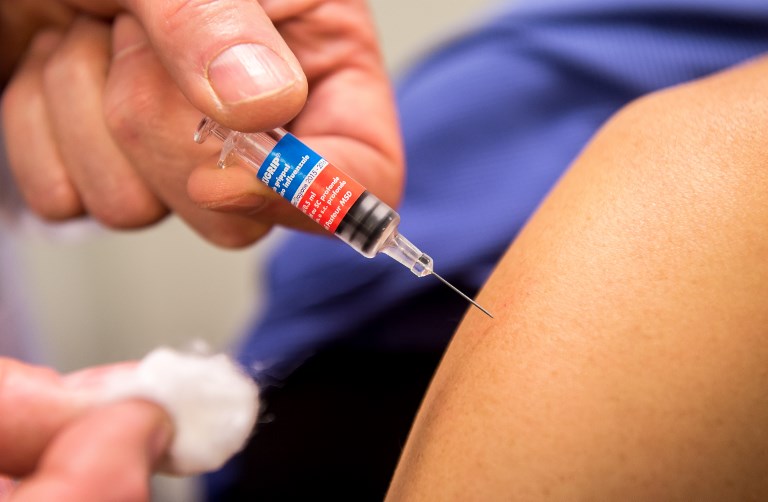
A person receives a vaccine against the flu as part of the yearly vaccination campaign, on October 8, 2015. AFP FILE
PARIS, France — Vaccines delivered via a painless, throw-away patch could one day eliminate the need for needle-and-syringe flu injections, researchers said Wednesday after completing a preliminary trial.
Equipped with micro-needles, the patches vaccinated against influenza just as effectively as a standard flu jab, they reported in the medical journal The Lancet.
“This bandage-strip sized patch of dissolvable needles can transform how we get vaccinated,” said Roderic Pettigrew, director of the US National Institute of Biomedical Imaging and Bioengineering, which funded the study.
The new technology can be self-administered and stored without refrigeration, making it significantly cheaper that traditional vaccines.
“It holds the promise for delivering other vaccines in the future,” Pettigrew added.
A hundred tiny needles — just long enough to penetrate the skin — embedded in each patch dissolve within minutes when exposed to moisture from the body.
Adhesive holds the patch close the skin while the vaccine is released, and can be peeled away after 20 minutes and discarded.
In phase I clinical trials, researchers from Emory University in Georgia and the Georgia Institute of Technology randomly divided 100 adults into four groups.
Three received the micro-needle patches: one delivered by a healthcare provider; one self-administered; and the third — delivered by a nurse — a placebo without any active ingredients.
The fourth group received a classic flu jab with a syringe.
All the active flu vaccines worked equally well for at least six months, regardless of whether they were delivered by professionals or the patient, or whether they were administered by a syringe or a micro-needle.
The manufacturing cost for the patches is expected to be about the same as for pre-filled syringes.
But the patch is expected to be cheaper because it can be sent through the mail and self-administered.
In addition, it is stable for a year at 40 degrees Celsius (104 degrees Fahrenheit), and does not require refrigeration, the researchers said.
“These advantages could reduce the cost of the flu vaccine and potentially increase coverage,” said lead author Nadine Rouphael, an associate professor at Emory. “Our findings now need confirming in larger trials.”
Mark Prausnitz, a professor at the Georgia Institute of Technology, led the design of the small coin-sized patch, and is co-founder of a company that is licensing the technology.
Despite recommendations for universal vaccination, less than half the population in the United States currently gets a flu jab. Influenza kills some 48,000 people in the US every year. CBB